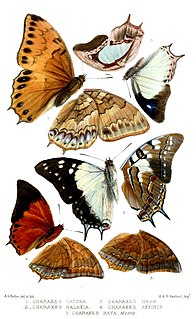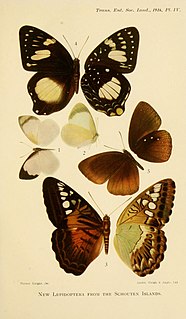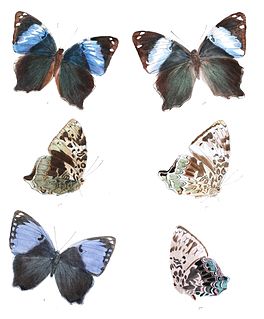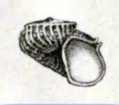| Prothoe | |
|---|---|
 | |
| Prothoe franck | |
| Scientific classification | |
| Kingdom: | Animalia |
| Clade: | Euarthropoda |
| Class: | Insecta |
| Order: | Lepidoptera |
| Family: | Nymphalidae |
| Tribe: | Prothoini |
| Genus: | Prothoe Hübner, [1824] |
| Species | |
Three, see text | |
Prothoe is a genus of charaxine butterflies in the family Nymphalidae. Two of the three species are virtually restricted to western and central Melanesia, but the most widespread species, P. franck, occurs throughout a large part of South-East Asia and as far northwest as Assam in India. [1]

The Charaxinae, the leafwings, are a nymphalid subfamily of butterflies that includes about 400 species, inhabiting mainly the tropics, although some species extend into temperate regions in North America, Europe, China, and southern Australia. Significant variations exist between the species. For example, some are medium sized and bright orange above, but mottled gray or brown below. This underwing coloration helps them resemble a dead leaf when they are at rest, as they keep their wings closed. With relatively few exceptions, the hindwings of the members of this subfamily have jagged edges.

The Nymphalidae are the largest family of butterflies with more than 6,000 species distributed throughout most of the world, belonging to the superfamily Papilionoidea. These are usually medium-sized to large butterflies. Most species have a reduced pair of forelegs and many hold their colourful wings flat when resting. They are also called brush-footed butterflies or four-footed butterflies, because they are known to stand on only four legs while the other two are curled up; in some species, these forelegs have a brush-like set of hairs, which gives this family its other common name. Many species are brightly coloured and include popular species such as the emperors, monarch butterfly, admirals, tortoiseshells, and fritillaries. However, the under wings are, in contrast, often dull and in some species look remarkably like dead leaves, or are much paler, producing a cryptic effect that helps the butterflies blend into their surroundings.

Melanesia is a subregion of Oceania extending from New Guinea island in the southwestern Pacific Ocean to the Arafura Sea, and eastward to Tonga.













